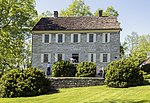Martinsburg, West Virginia
Cities in Berkeley County, West VirginiaCities in West VirginiaCounty seats in West VirginiaMartinsburg, West VirginiaPages with non-numeric formatnum arguments ... and 2 more
Populated places established in 1778Use mdy dates from July 2023

Martinsburg is a city in and the county seat of Berkeley County, West Virginia, United States. The population was 18,773 at the 2020 census, making Martinsburg the largest city in the Eastern Panhandle of West Virginia and the seventh-largest city in the state. It is a principal city of the Hagerstown–Martinsburg metropolitan area extending into Maryland, which had 293,844 residents in 2020.
Excerpt from the Wikipedia article Martinsburg, West Virginia (License: CC BY-SA 3.0, Authors, Images).Martinsburg, West Virginia
Henry Street, Martinsburg
Geographical coordinates (GPS) Address Nearby Places Show on map
Geographical coordinates (GPS)
| Latitude | Longitude |
|---|---|
| N 39.459166666667 ° | E -77.967777777778 ° |
Address
Henry Street
25401 Martinsburg
West Virginia, United States
Open on Google Maps











